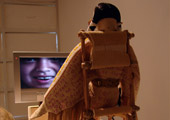
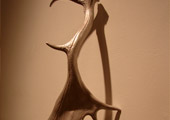


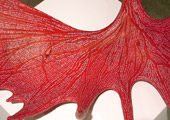
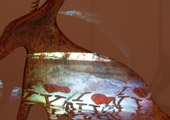

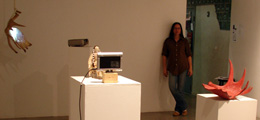
Click thumbnails to view images
![]()
Jude Norris
Digitized Dialects & Encoded Traditions; hybrid paradigms & affirmative transitions
May 22 to June 23 2007
Multi-disciplinary Cree-Métis artist, Jude Norris, employs idiosyncratic combinations of 'Native' material, language, traditional creative practice, and iconography with elements of western technology, art practice, theory, and language. Grounded by a strong aesthetic sensibility, and often a subtle humour, her work is an exploration and expression of the oddness and challenges of contemporary colonized reality.
Artist Statement
the antler series
The antler works are connected to the Affirm/Nation series through the use of repeated affirmations or statements, which either completely cover deer, moose, and caribou antlers, or run in a flowing fashion down the channels left by blood vessels on the antlers' surface. The naturally alluring shape of the antlers are at times accentuated through the use of intense, monochrome colour, in a similar fashion used in the braided and scar series. In the latter, and here again with the antlers, silver and gold are also employed for their symbolic association with technology and 'love of gold', and the odd contrast this makes in combination with such an organic form. There is also a commonality, though, as both the antlers and the metals are elements of battle and weaponry - and may be seen as referencing 'maleness'. In this respect, this series not only addresses the same issues of decolonization and healing as the other Affirm/Nation work, but also incorporates the relationship between male and female in this. This is expressed in a personal manner - as these works are in part like a collaboration between myself and the bulls and bucks who 'created' these wonderful objects.
Obviously, cultural relationships also come into play, as the antlers, being used as they are by an indigenous artist, cannot help but bring up traditional connection between First Nations people and the animals they (the antlers) belong to. Placed in such a contemporary context, they not only express a respectfulness, but also a questioning of where to place this relationship, particularly in the very specialized, Western context that the gallery may be seen to represent. The repeated affirmations used in earlier series continued and evolve on the antlers, where their communication expands to include sentences that represent traditional teachings, and well known statements from mainstream culture that mirror indigenous teachings.
In the latest antler works, the repeated handwriting extends into the use of computer code. On each 'coded' antler, one word from the traditional Cree teachings of the tipi pole - in which each pole is associated with a cultural value - translated into binary code. Similar to Cree syllabics in their strongly geometric form, the handwritten and repeated code takes on a 'tribal' aesthetic.
Permeating these layers of meaning, the fundamental tone of these works is one of celebration and awe at the creative process found mirrored in every aspect of the natural world, and these animals may be seen as teachers - not just in their behavior, but in their ability to create objects that are not only superb tools, but are also aesthetically stunning."
Buffalo Basket
"The entire basket of the cart is woven with red willow. Attached to the top of the cart is a rounded willow framework. This structure is covered in hide, making it look much like a sweat lodge. There is a small opening on the front of the rounded top, through which a person may look within. The interior of the basket is lined with moss, making it like a nest. In the centre of the nest sits a small video monitor, pointed upwards so that it is easily viewed when looking through the hole. The monitor shows looped video of various buffalo bulls, cows and calves. From the outside, the basket glows with the interior light of the monitor - but you cannot see inside at all until you are right up and bent over with your eye to the hole. Looking in, the interior is lit only by the light from the monitor. Before approaching, the loud bellowing of the buffalo bulls emanates from the cart, although the viewer is unlikely to know what this guttural sound is until getting close and looking inside the 'nest'.
This piece is a layered comment on how fundamental the buffalo were to my own and various other Plains people. I have repeatedly heard the bison called 'the supermarket' of the plains. The shopping cart obviously takes a poke at this analogy (even though I see it as fitting) - but the cart also refers to a kind of 'spiritual shopping'. It's well known that numerous plains cultures relied on this animal for physical wealth, but here there is also a reference to spiritual sustenance. The piece remembers how even though we no longer rely on the bison to anywhere near the same degree for food and shelter, this spiritual connection is still strong and fundamental.
The shopping cart also addresses the current search by many people for spiritual fulfillment - and both the negative and positive aspects of the current global thirst in this respect - a condition which leads more and more people to an interest in First Nations culture and spiritual practice - be it genuine or underscored by a consumerist mentality. Like another work in this series -'sacred story'- this piece is also concerned with the commercialization of culture. It takes an oblique, questioning poke at/into this issue. Are attempts to appropriate 'the sacred' truly a threat, and if so, in what respect? Are some things immune to 'consumption'?
On a more directly personal level, the basket also relates to something I heard an elder share once about how in a vision a buffalo had told her to ask women to weave baskets out of red willow and leave them for her as a way of helping the buffalo nation to thrive again. The nest-like aspect of the work is a continuation of a series of sculptural 'nests' I produced while living in London, England. Ironically it was during this time that I first really began to embrace my First Nations heritage. These nests in part mirror some of the warmth and comfort I found in beginning this process (like coming home to the nest) but at the same time symbolically provided 'comfort' to the challenges of this sometimes difficult journey."
Perfect Doll
"In this installation, a traditional plains-style faceless doll sits in front of a TV, apparently 'watching' images of her own creation.
The doll is small - about 10" in height - and wears a late 1800's-style buckskin dress, along with beaded moccasins & leggings. Her dress also has some beadwork edging - but it is predominantly decorated in small, hand-painted words. Three sentences - two in English and one in Cree syllabics - repeat themselves over the entire surface of exposed deer hide. These phrases are 'I am perfect, just as I am' ; the Cree translation of this sentence (which is something close to 'I am in a place of beauty, just as I am now') comes next, and this is followed by the statement 'There is no word for perfect in Cree'.
The doll has horsehair braids, and no facial features. This 'facelessness' was employed in plains cultures as a means of encouraging children's imaginative development. In this case, the facelessness may prompt the viewer to imagine other kinds of 'looking' besides the visual. It could also be read as a symbolic 'blindness' - an inability to see oneself, or aspects of oneself - even when faced with an apparently obvious image.
The doll sits in a small chair, facing a small monitor, which plays a tape loop of my hands in the process on sewing her and her clothes, and writing the words that adorn her dress. There is an audio track on the video loop. The viewer hears the Cree phrase of the dress spoken repeatedly by both an elder and a young girl. The elder also explains what that there is no direct translation for 'I am perfect' and how this, the nearest equivalent, translates in English. In between these spoken words, we hear the laughter of a number of girls.
The English affirmation is another reference to issues of insecurity, perfectionism, and recovery of self-esteem through the processes of self and cultural awareness, acceptance, and celebration. At the same time, the focus on the fact that there is no Cree translation emphasizes difference in cultural perspective, especially as it relates to relationship to self. The doll sits and watches her own creation. Because her own making involves a healing process, she is watching herself evolve. The doll is both a representative of culture and a self-portrait. She is looking at herself, me, and the creative act - and how we are/this is all a part of the Creator. She also symbolizes the importance of playfulness, and the importance of maintaining a child-like attitude in order to continue to learn and grow.
In all these contexts, the point is a gentle movement toward acceptance of that which she symbolizes as being in a state of on-going evolution - which is always in a state of 'perfection' - i.e. 'beauty' - no matter the at times seemingly insurmountable personal or communal challenges.
The Cree words being spoken by a young girl - and the girls' laughter - as well as the doll herself - point toward cultural teachings as an important means in this movement toward/back to a better perspective. Dolls were an integral part of a girl's learning process - about herself, and her responsibilities and roles within her family and community. For countless generations, similar dolls - beautiful creative acts of women - were used as educational tools. The girls' voices also reflect on how many women, myself included, did not experience this kind of education. Some of us have been lucky enough to experience some of this in adulthood and realize how relevant it can be for coming generations. As it is in other works involving Cree, my own 'cultural' education is also encased in this piece as it becomes evidence and story of the process of learning my own language."
![]() Jude is a recent recipient of a Chalmer's Arts Fellowship, and has received awards from the Canada Council, the Alberta Foundation for the Arts, the Ontario Arts Council, and the Toronto Arts Council. Her work has been exhibited internationally.
Jude is a recent recipient of a Chalmer's Arts Fellowship, and has received awards from the Canada Council, the Alberta Foundation for the Arts, the Ontario Arts Council, and the Toronto Arts Council. Her work has been exhibited internationally.
